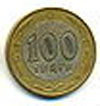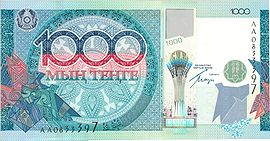|


The tenge (Kazakh: теңге, teñge) is the currency of Kazakhstan. It is divided into 100 tïın (тиын, also transliterated as tiyin or tijn). It was introduced on 15th of November 1993 to replace the Soviet ruble at a rate of 1 tenge = 500 rubles. The ISO-4217 code is KZT.
The word tenge in the Kazakh and most other Turkic languages means a set of scales. The origin of the word is the Turkic teğ- which means being equal, balance. The name of this currency is thus similar to the lira, pound and peso. The name of the currency is related to the Russian word for money Russian: деньги / den'gi, which was borrowed from Turkic.
History
Kazakhstan was one of the last countries of the CIS to introduce a national currency. In 1991 a "special group" of designers was created: Mendybay Alin, Timur Suleymenov, Asimsaly Duzelkhanov and Khayrulla Gabzhalilov. On November 12, 1993, a decree of the President of Kazakhstan, "About introducing national currency of Republic of Kazakhstan", was issued. On November 15, 1993, the tenge was brought into circulation. As such, November 15 is celebrated as the "Day of National Currency of Republic of Kazakhstan". In 1995, a tenge printing factory was opened in Kazakhstan. The first consignment of tenge was printed abroad, in the U.K.. The first coins were minted in Germany.
March 20, 2007 two days before the Nauryz holiday, the National Bank of Kazakhstan approved a graphical symbol for the Tenge. The character was proposed for encoding in Unicode in March 2008 It was released at the codepoint U+20B8 ₸ tenge sign as of Unicode 5.2.
Coins
In 1993, coins were introduced in denominations of 2, 5, 10, 20 and 50 tiyn, 1, 3, 5, 10 and 20 tenge. 50 tenge were introduced in 1997, followed by 100 tenge in 2002 and 2 tenge in 2005. Coins currently in circulation are:
* 1 tenge (Brass)
* 2 tenge (Brass)
* 5 tenge (Brass)
* 10 tenge (Brass)
* 20 tenge (Copper-Nickel)
* 50 tenge (Copper-Nickel)
* 100 tenge (Bimetallic, Brass and Copper-Nickel)
Commemorative coins are issued in denominations of 20, 50, 100, 500, 1000, 2500, 5000 and 10000 tenge. Investment coins exist in denominations of 1, 2, 5, 10, 20, 50 and 100 tenge.
Banknotes
1993 series
In 1993, the National Bank of Kazakhstan issued notes in denominations of 1, 2, 5, 10, 20 and 50 tiyn, 1, 3, 5, 10, 20, 50, 100 and 200 tenge. These were followed by 500 and 1000 tenge notes in 1994. 2000 tenge notes were introduced in 1996, with 5000 tenge in 1998 and 10,000 tenge in 2003. Notes currently in circulation are:
* 200 tenge portrait of Al-Farabi
* 500 tenge portrait of Al-Farabi, fragment of Khodzha Akhmet Yassaui mausoleum
* 1000 tenge portrait of Al-Farabi
* 2000 tenge portrait of Al-Farabi
* 5000 tenge portrait of Al-Farabi
* 10,000 tenge portrait of Al-Farabi, image of snow leopard.
Interestingly, the text on the reverse side of 200 tenge banknote is written in Kazakh, although text on the reverse sides of the other banknotes is written in Russian.
2006 banknotes
The National Bank of Kazakhstan issued banknotes of new series in 2006. They have the same values as the previously existed ones.
The 2006 series is far more exotic than its predecessors. The obverse is vertical and the denomination is written in Kazakh. All denominations depict the Astana Bayterek monument, the flag of Kazakhstan, the Coat of arms, the handprint with a signature of president Nazarbayev and fragments of the national anthem. The main differences across each denomination are only the colours, the values, the underprint patterns.
On the contrast, the reverses are more differentiated. The value is written in Russian. Each denomination shows a unique building and geography of Kazakhstan in the outline of Kazakhstan border.
The first printing of the 2,000 and 5,000 tenge notes issued in 2006 had misspellings of the word for "bank" (the correct spelling "банкі" was misspelled "банқі"). The misspelling was a politically sensitive issue due to the cultural and political importance of the Kazakh language.
The text on this page has been made available under the Creative Commons Attribution-ShareAlike License and Creative Commons Licenses
|
